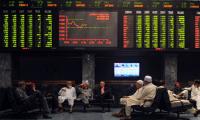KARACHI: The government more than doubled its borrowing from banks in the first half of the current fiscal year, as it struggled to cope with rising debt payments and inflationary pressures, central bank data showed on Tuesday.
The government borrowed Rs2.897 trillion from banks between July and mid-December, a 153 percent increase from the same period a year ago, according to data from the State Bank of Pakistan. The government borrowed Rs1.146 trillion in the same period last year.
Under the IMF’s $3 billion loan programme, Pakistan was able to secure immediate disbursement of $1.2 billion from the global lender along with financial support in the form of deposits as well as rollover from friendly countries. The IMF’s programme has also enabled Pakistan to secure funding from multilateral institutions like the World Bank and the Asian Development Bank. However, its borrowings from domestic sources remained higher.
The primary way the government borrows money from banks is by fortnightly auctioning of market treasury bills and conventional and Shariah-compliant bonds denominated in local currency. To finance its operations and pay back the borrowed funds, the government borrows money. Its burden of servicing domestic debt has increased significantly, according to analysts, because of record-high interest rates. Furthermore, the majority of government revenue is consumed by the high markup payments on domestic debt.
The government borrowed the biggest amount of money in a single auction in years on December 20, when it sold fixed-rate Pakistan Investment Bonds for an astounding Rs397 billion.
During the most recent T-bill auction, which was held on December 13, the government received bids from investors, specifically banks, totalling Rs4.6 trillion. Through the T-bill auction, the government was able to raise Rs2.2 trillion.
While the government continues to borrow heavily, banks are eagerly placing the majority of available liquidity in risk-free securities. Their investments in government papers are yielding larger returns, which is the cause.
The SBP has hiked its benchmark interest rate by a cumulative 15 percentage points to a record 22 percent since September 2021 to combat record-high inflation and shocks in energy and food prices.
The consumer price index inflation rose to 29.2 percent year-on-year in November due to an increase in energy prices to satisfy the reform targets required by the IMF's lending programme.
The government’s borrowing needs remained higher, despite a rise in tax revenue. The Federal Board of Revenue collected Rs3.5 trillion in taxes in the five months (July-November) of FY2024, up 30 percent from last year. The International Monetary Fund has set a tax collection target of Rs9.4 trillion for this fiscal year.
“On the expenditure side, we anticipate mark-up payments to soar to over Rs8 trillion in FY2024 owing to record high-interest rates and the Government’s unsatiating appetite for budgetary borrowings—with some respite kicking in FY2025 onwards as interest rates begin to decline,” said Taurus Securities in a report.
“The rest of the current expenditure including the share of provinces is expected to clock in at Rs11.8 trillion. This includes Rs1 trillion in budgeted subsidies as well as Rs1.9 trillion for the defence sector,” it added.
Since FY2018, total revenue receipts in nominal terms have grown at a compound annual growth rate (CAGR) of 13 percent with development spending growing at a CAGR of 4 percent only. On the other hand, markup payments have increased at a startling 31 percent CAGR. This explains why financial limitations have prompted the government to reduce development spending.
“The Government has already decided to end 137 development projects worth Rs116 billion for FY2024 on IMF demands to meet the targets for fiscal deficit set under the stand-by arrangement. Resultantly, the size of the Federal PSDP [public sector development programme] may be reduced to Rs834 billion compared to the budgeted allocation of Rs950 billion for the current fiscal year,” the report noted.
The commencement of the easing cycle may prove critical in creating some fiscal space for the federal government so that development spending remains on track—supporting economic growth, according to the report.
The picture shows a logo of Federation of Pakistan Chambers of Commerce & Industry . — APP/FileKARACHI: Atif Ikram...
The image shows the logo of the Securities and Exchange Commission of Pakistan . — APP/FileISLAMABAD: The Securities...
This image released on January 26, 2023, shows the logo of Archroma. — Facebook/ArchromaKARACHI: Archroma Pakistan...
The logo of the Trade Development Authority of Pakistan . — TDAP website. Mirpur: Kausar Taqadus Gilani, Minister...
This representational image shows Gold bars. — AFP/FileKARACHI: Gold prices in the local market dropped by Rs600 per...
Security personnel walk past the US Federal Reserve building in Washington, DC on Oct 22, 2021. —...







